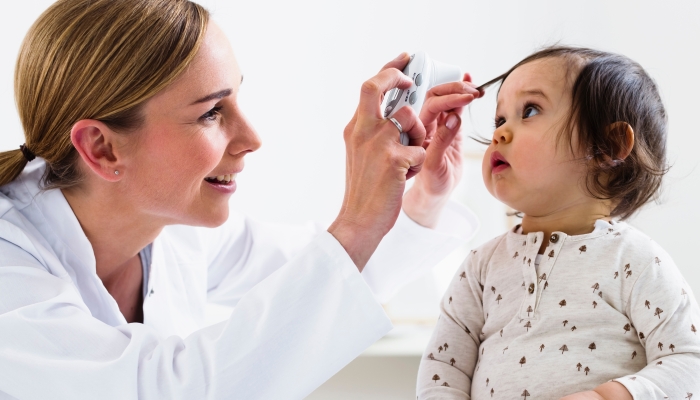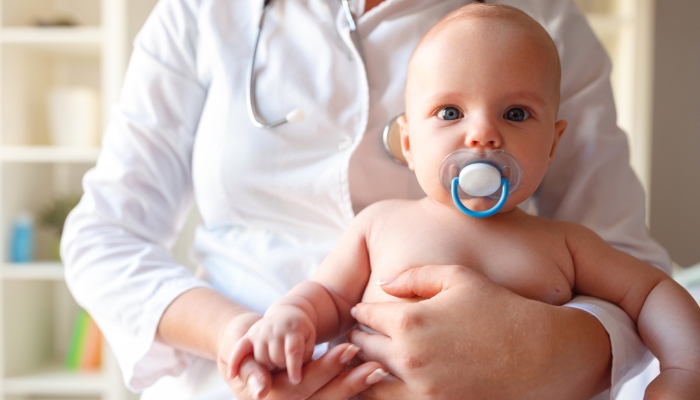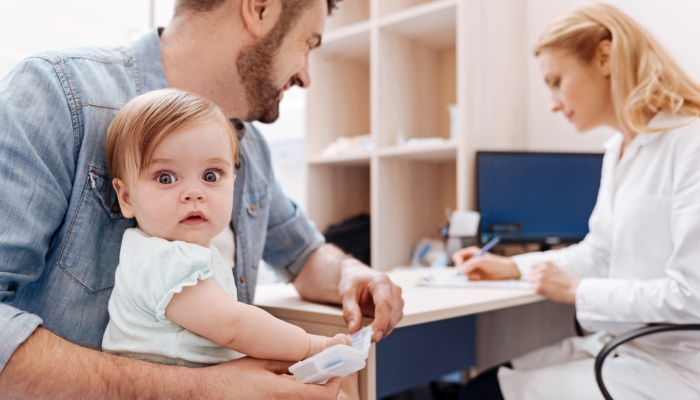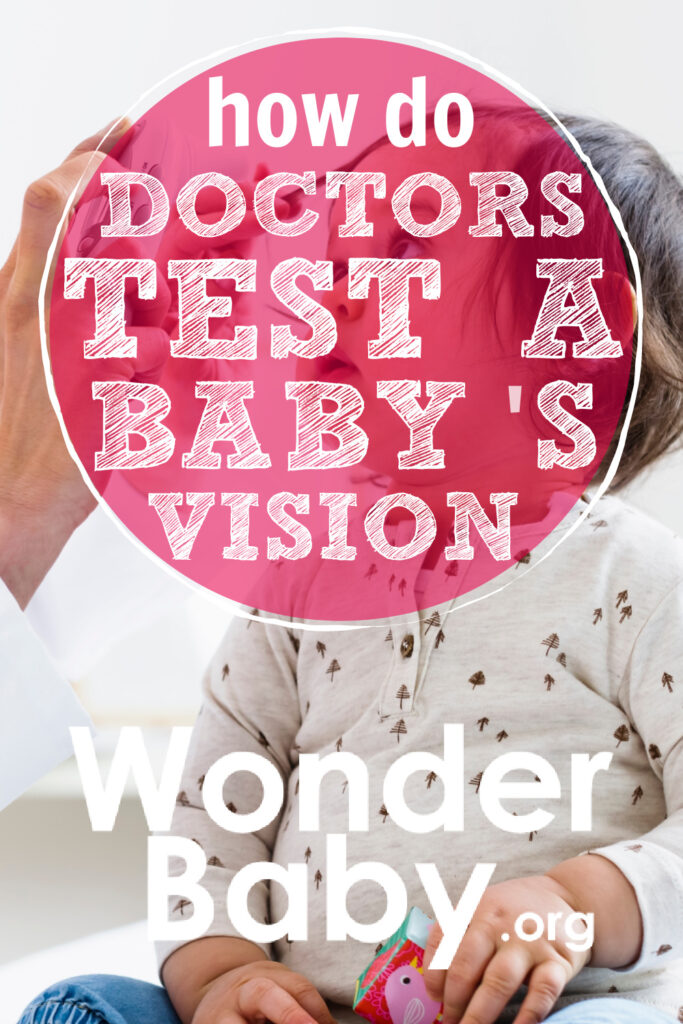How Do Doctors Test a Baby’s Vision

- Routine vision screening and eye exams are essential parts of maintaining your child’s eye health.
- Contact your child’s eye doctor if you notice unusual vision symptoms.
- There are many ways you can help your baby through their first vision screening.
Your baby’s vision is an important part of their overall health. As babies begin exploring their world, you may notice eye or vision problems as you watch your little one interact with others.
Since babies aren’t able to say if they’re experiencing eye or vision problems, they rely on their caregivers to watch for abnormal eye movements or symptoms.
If you’ve ever worn glasses, you may be thinking of your own experiences with an eye exam or vision screening and wonder how it applies to your baby. How do doctors test a baby’s vision?
Healthy eyes are important for your baby as they continue to develop and learn about the world. But how do you know when it’s time to seek an expert’s opinion?
Baby Vision Test: What Parents Need to Know
There’s a lot to know when it comes to your child’s vision. How do you determine your child’s visual health and ensure they’re developing properly?
What is a Baby Vision Test?
According to the American Academy of Pediatrics, a vision screening (or vision test) is “a brief eye and vision check to help detect vision issues in children. It is an essential part of preventative eye care.”
Who Performs a Baby Vision Test?
Most babies who have healthy eyes and good vision are safe to have their vision evaluated by their regular healthcare provider.
Your child’s doctor is an important part of their healthcare team. It’s this physician’s responsibility to perform routine eye exams and vision screenings for early detection of possible conditions, as well as to promote overall eye health.
For children with special health care needs or certain genetic conditions, such as Down’s Syndrome, it may be preferential to have these children’s eyes routinely examined by a specialist.
When Should You Get Your Baby’s Vision Tested?

According to the American Optometric Association (AOA), your child should have their first comprehensive eye examination performed by a qualified eye doctor by six months of age. If no problems are identified at that time, a second eye exam is highly recommended before your child starts preschool or kindergarten.
However, you may suspect differences in your child’s vision before six months of age. Contact your child’s healthcare provider or an eye doctor if you notice any of the below symptoms.
Unusual Eye Symptoms
The American Academy of Pediatrics recommends that parents contact their child’s pediatrician if they note these signs and symptoms:
- Inability to follow or track an object with their eyes (if your baby is greater than three months old)
- Difficulties with depth perception (if your baby is greater than five months old)
- Eyes that are misaligned (look crossed, turn out, or don’t focus together)
- White or grayish color in the pupil
- Eyes that move quickly from side to side or up and down (nystagmus)
- Blurred vision
- Eye pain or itchiness
- Pus or crust in either eye
- Excessive tearing or wateriness
- Eyes that seem overly sensitive to light
Early detection of possible eye problems is key to maintaining good eye health and preventing long-term vision problems.
Visual Stimming
Visual stimming refers to a person’s use of rhythmic, repetitive movements to calm oneself or to “wake up” parts of the brain if feeling bored.
While stimming is usually associated with autism, individuals with other conditions (such as ADHD) can also employ this technique to help themselves regulate their emotions.
It’s important to note that neurotypical babies and children engage in stimming too. However, these behaviors typically diminish as the child’s age increases.
Trouble with Visual Motor Skills
Eye doctors from the American Optometric Association reported that a baby’s eyes begin working together in the first months of life. At approximately five months of age, the eye muscles and eye structures are able to coordinate in such a way that depth perception (binocular vision) is formed.
If your baby struggles with eye-hand coordination or other skills, most doctors agree that an evaluation by an eye doctor is needed to evaluate for any health issues.
Who Performs a Baby Vision Test?
Simple vision screening tests occur as a regular part of each well-child visit in the hospital and the doctor’s office. Your family doctor may pass a bright light in front of your child’s eyes, watching their pupillary response, red reflex, and overall reaction to the light.
If your child’s pediatrician suspects early signs of an eye condition or is concerned about your infant’s visual development, you may be referred to an eye specialist or pediatric ophthalmologist for further evaluation.
What to Expect During a Baby Vision Test?
Pediatric ophthalmologists generally divide their eye exams into two parts: Patient history and physical exam.
History
The first aspect of the exam will be the completion of a detailed patient history. Come prepared to discuss:
- Family history. Many eye and vision problems, such as Leber’s congenital amaurosis (LCA), tend to be genetically inherited. Your eye doctor may recommend genetic testing for your child or other family members.
- Pregnancy history. Include such information as alcohol or substance use when discussing your pregnancy, as well as infections you may have had while pregnant.
- Birth history. Describe whether your child was born prematurely or full term, as well as the presence of any birth trauma or resuscitation. If your baby received oxygen for a prolonged period after birth, that can be important information for your eye specialist.
- Discussion of symptoms. Remember: You are the expert on your child. Your observations are crucial in aiding your eye doctor to establish a diagnosis. Describe your child’s visual abilities, eye movements, and any patterns you’re able to identify.
A thorough patient history will give your eye doctor some insight as to what they may notice during your baby’s eye exam.
Physical Exam
Next, the eye doctor will examine your baby. Their assessment of your baby’s visual system may include:
- Visual testing. Though your baby won’t be able to complete an eye chart like a school-age child, an assessment of eye alignment, capability, and function is still possible. The eye doctor may use an object, such as a toy, to determine your child’s ability to focus and track objects as part of determining visual acuity.
- Physical exam. As part of a complete eye exam, a pediatric ophthalmologist will use eye drops to dilate your child’s pupils so they can observe the blood vessels and eye structures inside your baby’s eyes. This visualization can be done by using an ophthalmoscope (magnifying glass attached to a lighted instrument) to see inside your child’s eyes in a darkened room.
After completing a physical exam of your baby, your child’s eye doctor will be better equipped to know if your child’s eyes are developing properly.
What Happens After a Baby Vision Test?

At the end of your child’s vision tests, the pediatric ophthalmologist will discuss their impressions of your baby’s eyes and, if indicated, outline a course of treatment or follow-up.
Your eye doctor may complete a patient history, eye exam, and discussion in the same appointment or schedule a separate session to talk through the interpretation of their findings and a proposed treatment plan. Your doctor may suggest further testing using different instruments, like an electroretinogram (ERG) which can measure the retina’s response to light stimuli.
It’s important to remember that any diagnosis of vision impairment will be made after a complete evaluation by a qualified provider.
How to Help Your Baby Through A Vision Test
The benefit of going to a pediatric ophthalmologist’s office for your baby’s eye care is that they specialize in childhood eye conditions and are familiar with children of all ages.
How babies approach an eye exam is developmentally different from that of older children or young adults, and will involve different skills to ease them through the appointment.
Consider the following suggestions when preparing for your baby’s vision test:
- Timing. Very young children may not appreciate having their eyes tested when they’re sleepy. If possible, consider scheduling appointments around your baby’s nap times.
- Vision play. If possible, practice with some elements of the physical exam before your trip to the eye doctor’s office. Most babies are curious creatures and may tolerate playing with a flashlight or letting you “pretend” to peek into their eyes.
- Preparation is key. Bring a favorite lovey or blanket, as well as some familiar toys and books. It can take several minutes for the dilating eye drops to take effect, and you’ll want something to occupy your child.
- Expect some resistance. It can be very disconcerting for young children to have bright lights flash in their eyes or to have the world suddenly go blurry with dilating eye drops. Bringing a familiar adult and comfort objects will help reassure your child.
- Ask about positioning. Many babies are more willing to sit up for an exam if they’re positioned on your lap. Alternatively, some pieces of the exam can be done lying on your lap too. Being flexible with positioning tends to help everyone in the room relax and participate fully in the exam.
Having your baby’s vision checked regularly is an important part of preventing eye or vision problems. The ability to see clearly has a great impact on a baby’s life as they continue to develop and grow.

The information WonderBaby provides is not intended to be, and does not constitute, medical or other health advice or diagnosis and should not be used as such. Always consult with a qualified medical professional about your specific circumstances.
Related Posts

Eye Conditions and Syndromes, Visual Impairment
Neuralink Announces Plans to Restore Sight to the Blind with Brain Chip
Elon Musk’s company Neuralink has announced plans to begin human trials of its new “Blindsight” brain chip by the end of 2025.

Special Needs
5 Spring Cleaning Tips for Families of Children with Disabilities
Spring cleaning is an opportunity to create a more accessible, organized, and supportive space for your child with disabilities. Declutter, deep clean, and refresh!

Visual Impairment
The Gift of Understanding: How a Young Child Helps His Blind Father Navigate Life
When a parent is blind, it’s natural for people to wonder how their sighted child will adapt. Will they struggle to understand their parent’s needs? Will they feel burdened by...